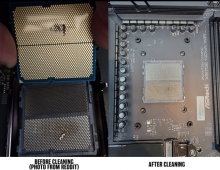
AMD To Inegrate ARM's Core In Future APUs
Through a technology partnership with ARM, AMD will
integrate the ARM TrustZone technology into future
Accelerated Processing Units (APUs) via a
system-on-a-chip (SoC) design methodology.
AMD will integrate an ARM processor with upcoming x86 chips, starting next year. The new AMD chips will integrate ARM's Cortex-A5 processor with TrustZone security technology, the company said. The technology would offer consumers secure access to
their content and worry-free online transactions.
By adopting the approach to security that TrustZone technology embodies, AMD and ARM will provide a consistent approach to security spanning billions of Internet-connected mobile devices, tablets, PCs and servers − whether they are powered by ARM processor-based solutions or AMD x86 APUs. AMD plans to provide development platforms that have TrustZone security features on select APUs in 2013, expanding further across its product portfolio in 2014.
In a presentation this week at the AMD Fusion Developer Summit 2012 (AFDS), AMD Senior Vice President and Chief Information Officer Mike Wolfe described AMD's vision to advance computing security by enhancing AMD's existing security technologies. This is expected to include developing a platform security processor using an ARM Cortex-A5 CPU that features TrustZone technology, to monitor and help protect against malicious access to sensitive data and operations at the hardware level.
"With AMD's support for, and inclusion in, the expanding TrustZone ecosystem, consumers and businesses can rest assured their data and content are secured by an industry-standard security solution that spans a multitude of devices and operating systems," said Wolfe.
"This example of AMD's ambidextrous strategy, which leverages our history of x86 and graphics innovation while also embracing other technologies and intellectual property, will help drive a more secure computing experience for our consumer and businesses customers."
"As technology becomes more important to our everyday lives, security needs to be present in every single device. The challenge that the industry faces is how to make this a reality," said Ian Drew, executive vice president, strategy, ARM. "Through this technology partnership with AMD, and the broadening of the ARM TrustZone technology ecosystem, we're making another important step towards a solution. The aim is to make security accessible and consistent for consumers and business users across all computing devices."
The integration of an ARM processor is one of the first big steps from AMD in a plan to overhaul its chip design strategy. Under a new management team, AMD said in February it would change its design methodology to allow the integration of third-party intellectual property.
AMD's partnership with ARM could expand in the future to cover a wider range of technologies.
The ARM license is also AMD's way to catch up with Intel, which is integrating security features gained from its acquisition of McAfee last year.
By adopting the approach to security that TrustZone technology embodies, AMD and ARM will provide a consistent approach to security spanning billions of Internet-connected mobile devices, tablets, PCs and servers − whether they are powered by ARM processor-based solutions or AMD x86 APUs. AMD plans to provide development platforms that have TrustZone security features on select APUs in 2013, expanding further across its product portfolio in 2014.
In a presentation this week at the AMD Fusion Developer Summit 2012 (AFDS), AMD Senior Vice President and Chief Information Officer Mike Wolfe described AMD's vision to advance computing security by enhancing AMD's existing security technologies. This is expected to include developing a platform security processor using an ARM Cortex-A5 CPU that features TrustZone technology, to monitor and help protect against malicious access to sensitive data and operations at the hardware level.
"With AMD's support for, and inclusion in, the expanding TrustZone ecosystem, consumers and businesses can rest assured their data and content are secured by an industry-standard security solution that spans a multitude of devices and operating systems," said Wolfe.
"This example of AMD's ambidextrous strategy, which leverages our history of x86 and graphics innovation while also embracing other technologies and intellectual property, will help drive a more secure computing experience for our consumer and businesses customers."
"As technology becomes more important to our everyday lives, security needs to be present in every single device. The challenge that the industry faces is how to make this a reality," said Ian Drew, executive vice president, strategy, ARM. "Through this technology partnership with AMD, and the broadening of the ARM TrustZone technology ecosystem, we're making another important step towards a solution. The aim is to make security accessible and consistent for consumers and business users across all computing devices."
The integration of an ARM processor is one of the first big steps from AMD in a plan to overhaul its chip design strategy. Under a new management team, AMD said in February it would change its design methodology to allow the integration of third-party intellectual property.
AMD's partnership with ARM could expand in the future to cover a wider range of technologies.
The ARM license is also AMD's way to catch up with Intel, which is integrating security features gained from its acquisition of McAfee last year.





















